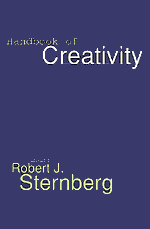Book contents
- Frontmatter
- Contents
- List of Contributors
- Preface
- Handbook of Creativity
- PART I INTRODUCTION
- PART II METHODS FOR STUDYING CREATIVITY
- PART III ORIGINS OF CREATIVITY
- PART IV CREATIVITY, THE SELF, AND THE ENVIRONMENT
- 10 Creative Cognition
- 11 From Case Studies to Robust Generalizations: An Approach to the Study of Creativity
- 12 Creativity and Knowledge: A Challenge to Theories
- 13 Creativity and Intelligence
- 14 The Influence of Personality on Artistic and Scientific Creativity
- 15 Motivation and Creativity
- 16 Implications of a Systems Perspective for the Study of Creativity
- PART V SPECIAL TOPICS IN CREATIVITY
- PART VI CONCLUSION
- Author Index
- Subject Index
13 - Creativity and Intelligence
Published online by Cambridge University Press: 05 June 2014
- Frontmatter
- Contents
- List of Contributors
- Preface
- Handbook of Creativity
- PART I INTRODUCTION
- PART II METHODS FOR STUDYING CREATIVITY
- PART III ORIGINS OF CREATIVITY
- PART IV CREATIVITY, THE SELF, AND THE ENVIRONMENT
- 10 Creative Cognition
- 11 From Case Studies to Robust Generalizations: An Approach to the Study of Creativity
- 12 Creativity and Knowledge: A Challenge to Theories
- 13 Creativity and Intelligence
- 14 The Influence of Personality on Artistic and Scientific Creativity
- 15 Motivation and Creativity
- 16 Implications of a Systems Perspective for the Study of Creativity
- PART V SPECIAL TOPICS IN CREATIVITY
- PART VI CONCLUSION
- Author Index
- Subject Index
Summary
What is the relationship between creativity and intelligence? Creativity has often been defined as the process of bringing into being something novel and useful. Intelligence may be defined as the ability to purposively adapt to, shape, and select environments (Sternberg, 1985a). Although there are many other definitions of both intelligence (see “Intelligence and Its Measurement,” 1921; Sternberg & Detterman, 1986) and creativity (see Glover, Ronning, & Reynolds, 1989; Policastro & Gardner, Chapter 11, this volume; Rothenberg & Hausman, 1976; Sternberg, 1988), these definitions tend to share at least some elements with these consensual definitions.
What about the relationship between the two? R. Ochse (1990) said, “If intelligence means selecting and shaping environments, it is creativity” (p. 104). In order to select or shape the environment to suit oneself, one requires the imagination to create a vision of what the environment should be and of how this idealized environment can become a reality. On the other hand, the ability to adapt to the environment - to change oneself to suit the environment - typically involves little or no creativity, and may even require one to suppress creativity, as when one realizes that adaptation to a school or job environment means keeping one's creative ideas to oneself, or else risking a low grade or job evaluation. According to Getzels and Csikszentmihalyi (1972), creativity and intelligence may represent different processes and intelligence may be required in widely varying degrees in different fields of creative endeavor.
- Type
- Chapter
- Information
- Handbook of Creativity , pp. 251 - 272Publisher: Cambridge University PressPrint publication year: 1998
- 42
- Cited by



